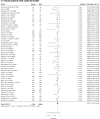Eyelid dermatitis in patch-tested adult patients: a systematic review with a meta-analysis
- PMID: 39138344
- PMCID: PMC11322306
- DOI: 10.1038/s41598-024-69612-z
Eyelid dermatitis in patch-tested adult patients: a systematic review with a meta-analysis
Abstract
Eyelid dermatitis (ED) affects a cosmetically significant area and leads to patients' distress. Despite ongoing and recent research efforts, ED remains a multidisciplinary problem that needs further characterization. We aimed to evaluate the atopic eyelid dermatitis (AED) frequency in ED patients and to perform their clinical profiling. PubMed databases were searched from 01.01.1980 till 01.02.2024 to PRISMA guidelines using a search strategy: (eyelid OR periorbital OR periocular) AND (dermatitis or eczema). Studies with patch-tested ED patients were included. Proportional meta-analysis was performed using JBI SUMARI software. We included 65 studies across Europe, North America, Asia and Australia, with a total of 21,793 patch-tested ED patients. AED was reported in 27.5% (95% CI 0.177, 0.384) of patch-tested ED patients. Isolated ED was noted in 51.6% (95% CI 0.408, 0.623) of 8453 ED patients with reported lesion distribution, including 430 patients with isolated AED. Our meta-analysis demonstrated that the AED frequency in patch-tested ED patients exceeded the previous estimate of 10%. Isolated AED was noted in adult patients, attending contact allergy clinics. Future studies are needed to elucidate the global prevalence and natural history of isolated AED in adults.
© 2024. The Author(s).
Conflict of interest statement
EB serves on the WAO Committee on Atopic Dermatitis, received honoraria for educational lectures from Novartis and Sanofi and research funding from GSK, outside the submitted work. EB provided
Figures












Similar articles
-
Eyelid dermatitis: an evaluation of 150 patients.Contact Dermatitis. 1992 Sep;27(3):143-7. doi: 10.1111/j.1600-0536.1992.tb05242.x. Contact Dermatitis. 1992. PMID: 1451457
-
Eyelid dermatitis in patients referred for patch testing: Retrospective analysis of North American Contact Dermatitis Group data, 1994-2016.J Am Acad Dermatol. 2021 Apr;84(4):953-964. doi: 10.1016/j.jaad.2020.07.020. Epub 2020 Jul 15. J Am Acad Dermatol. 2021. PMID: 32679276
-
Periorbital dermatitis--a recalcitrant disease: causes and differential diagnoses.Br J Dermatol. 2008 Sep;159(4):858-63. doi: 10.1111/j.1365-2133.2008.08790.x. Epub 2008 Aug 21. Br J Dermatol. 2008. PMID: 18721191
-
Allergic contact dermatitis of the eyelids: An interdisciplinary review.Ocul Surf. 2023 Apr;28:124-130. doi: 10.1016/j.jtos.2023.03.001. Epub 2023 Mar 9. Ocul Surf. 2023. PMID: 36898500 Review.
-
Pediatric Allergic Contact Dermatitis.Immunol Allergy Clin North Am. 2021 Aug;41(3):393-408. doi: 10.1016/j.iac.2021.04.004. Epub 2021 Jun 5. Immunol Allergy Clin North Am. 2021. PMID: 34225896 Review.
References
Publication types
MeSH terms
LinkOut - more resources
Full Text Sources
Medical

